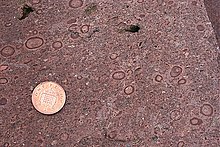Ullapool bolide impact
| Stac Fada Member Stratigraphic range: Mesoproterozoic |
|
|---|---|

Accretionary lapilli from the Stac Fada Member
|
|
| Type | Member |
| Unit of | Bay of Stoer Formation, Stoer Group |
| Underlies | Poll a' Mhuilt Member |
| Thickness | 4 to 10.5 m |
| Location | |
| Country | Scotland |
| Extent | 55 km along the coast of NW Scotland |
| Type section | |
| Named for | Stac Fada, a small headland west of Stoer |
The Stac Fada Member is a distinctive layer towards the top of the Mesoproterozoic Bay of Stoer Formation, part of the Torridonian Supergroup. This rock unit is 10 to 15 metres thick and is made of sandstone that contains accretionary lapilli and many dark green glassy fragments of mafic composition.
Evidence for a bolide impact centered on Ullapool or Lairg has been published and refined in studies in 2008 and 2016. It is prospectively the fifteenth largest impact crater on Earth, is 25 miles across, dating from 1.2 billion years ago.
Evidence for a bolide impact centered on Ullapool was published by a combined team of scientists from the University of Oxford and the University of Aberdeen, in March 2008.
The evidence is centred on Ullapool, a harbour town on Loch Broom in the Ross and Cromarty district of the Highland council area of northwest Scotland. It may have been the largest known bolide impact ever to strike what are now the British Isles. The impact, which has been dated to about 1.18 Ga, melted rock at the site and left parallel shock fractures in quartz and biotite and a tell-tale trace of iridium. Centered on the impact crater, a wide ejecta field has been traced, some 50 km across, forming the Stac Fada member within the Stoer Group of the Torridonian. The affected layer of rock, which on land stretches from Gairloch in the south to Stoer in the north is six to 22 metres thick. Until recently, these anomalous formations were unsatisfactorily credited to an isolated instance of volcanism.
...
Wikipedia
